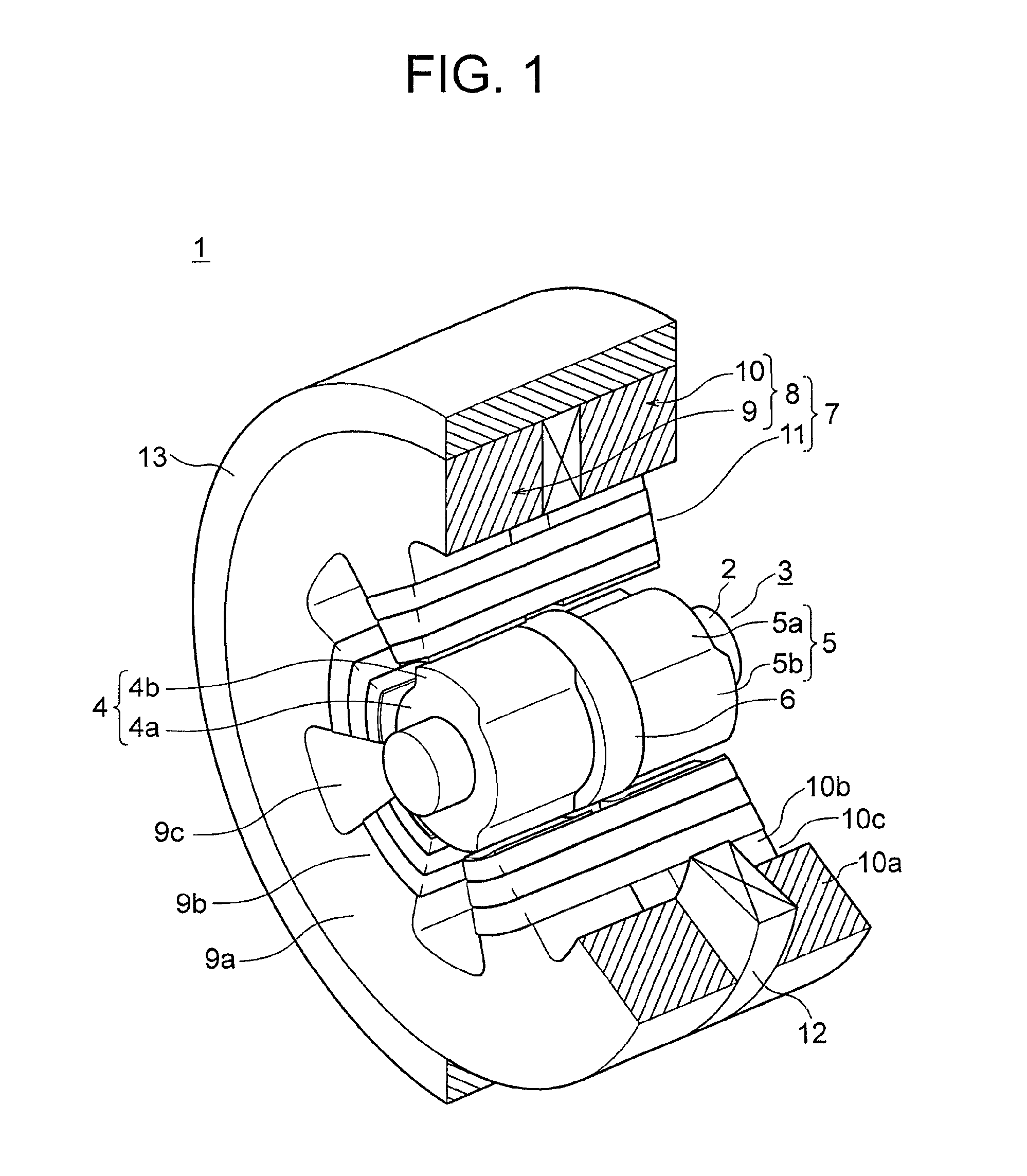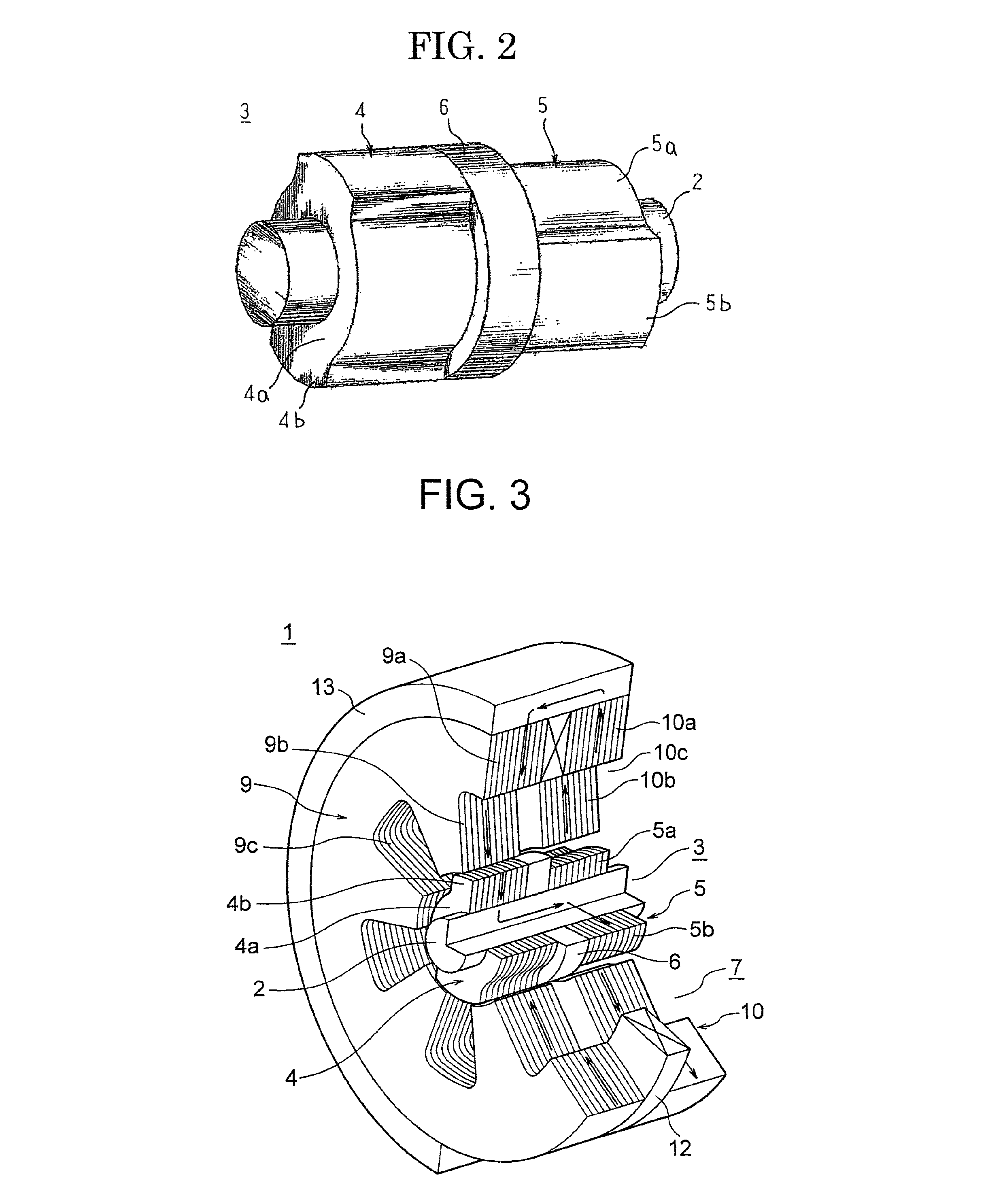Magnetic inductor rotary machine and fluid transfer apparatus that uses the same
a technology of magnetic inductor and rotary machine, which is applied in the direction of magnetic circuit rotating parts, piston pumps, and shape/form/construction of magnetic circuits, which can solve problems such as axial resonance and interference between bearings and coil ends of stator coils, and achieve the effects of reducing the magnetic resistance between the rotor and the stator, and reducing the amount of magnetic flux
- Summary
- Abstract
- Description
- Claims
- Application Information
AI Technical Summary
Benefits of technology
Problems solved by technology
Method used
Image
Examples
embodiment 1
[0028]FIG. 1 is a partially cut away perspective that shows a configuration of a rotary machine according to Embodiment 1 of the present invention, and FIG. 2 is a perspective that shows a configuration of a rotor that can be used in the rotary machine according to Embodiment 1 of the present invention.
[0029]In FIGS. 1 and 2, a rotary machine 1 is a magnetic inductor synchronous rotary machine, and includes: a rotor 3 that is fixed coaxially to a rotating shaft 2 that is prepared using a solid magnetic body of iron, etc.; a stator 7 that is formed by mounting a stator coil 11 that functions as a torque generating driving coil to a stator core 8 that is disposed so as to surround the rotor 3; a field coil 12 that functions as a field means; and a housing 16 that houses the rotor 3, the stator 7, and the field coil 12.
[0030]The rotor 3 includes: first and second rotor cores 4 and 5 that are prepared, for example, by laminating and integrating a large number of magnetic steel plates th...
embodiment 2
[0063]FIG. 8 is a partially cut away perspective that shows a rotary machine according to Embodiment 2 of the present invention. Moreover, a stator coil has been omitted in FIG. 8.
[0064]In FIG. 8, a first stator core 9A includes: a cylindrical core back 9a; and six teeth 9b that are disposed so as to project radially inward from an inner peripheral surface of the core back 9a at a uniform angular pitch circumferentially. Flange portions 9d are disposed so as to extend in two circumferential directions from inner peripheral end portions of the teeth 9b to reduce opening widths of the slots 9c. A second stator core 10A is prepared into an identical shape to the first stator core 9A, and flange portions 10d are disposed so as to extend in two circumferential directions from inner peripheral end portions of teeth 10b to reduce opening widths of slots 10c.
[0065]Moreover, the rest of the configuration is configured in a similar manner to Embodiment 1 above.
[0066]In a rotary machine 1A th...
embodiment 3
[0069]FIG. 9 is a partially cut away perspective that shows a rotary machine according to Embodiment 3 of the present invention. Moreover, a stator coil has been omitted in FIG. 9.
[0070]In FIG. 9, a first permanent magnet 41 that functions as a magnetic field means is interposed in a state of close contact between a core back 9a of a first stator core 9A and an outer peripheral surface of a housing 13, and is magnetically oriented such that a direction of magnetization 43 is oriented radially inward. A second permanent magnet 42 that functions as a magnetic field means is interposed in a state of close contact between a core back 10a of a second stator core 10A and an outer peripheral surface of a housing 13, and is magnetically oriented such that a direction of magnetization 43 is oriented radially outward.
[0071]Moreover, the rest of the configuration is configured in a similar manner to Embodiment 2 above.
[0072]A rotary machine 1B that is configured in this manner, operates in a s...
PUM
 Login to View More
Login to View More Abstract
Description
Claims
Application Information
 Login to View More
Login to View More - R&D
- Intellectual Property
- Life Sciences
- Materials
- Tech Scout
- Unparalleled Data Quality
- Higher Quality Content
- 60% Fewer Hallucinations
Browse by: Latest US Patents, China's latest patents, Technical Efficacy Thesaurus, Application Domain, Technology Topic, Popular Technical Reports.
© 2025 PatSnap. All rights reserved.Legal|Privacy policy|Modern Slavery Act Transparency Statement|Sitemap|About US| Contact US: help@patsnap.com



